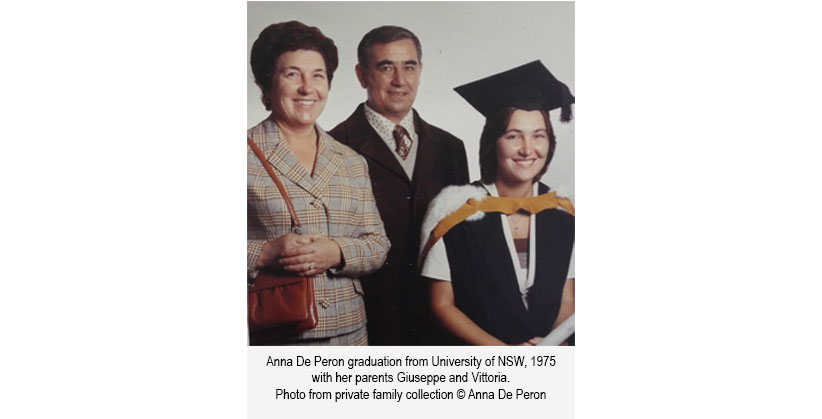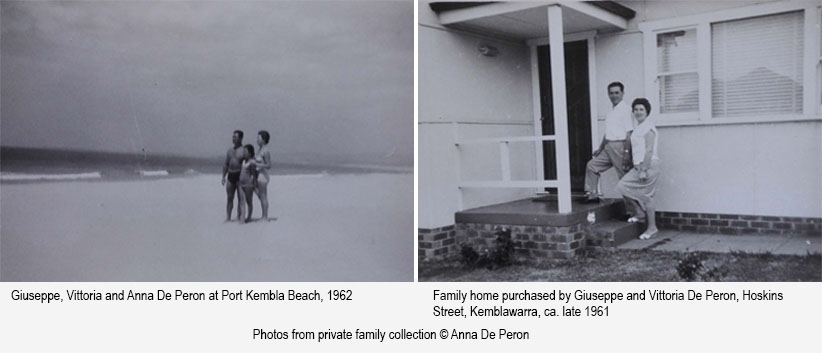Anna De Peron was born Italy and migrated to Australia with her parents, Giuseppe and Vittoria, in 1961. The family settled in Illawarra after first being sent to Bonegilla. This is her story.
“My dad decided to migrate to Australia in 1960. In Italy he worked as a specialized technician manufacturing ladies’ stockings. It was a very well-paid job but when new technology was introduced a large proportion of the workers were made redundant. My father was worried that his job was on the line, and at 37, finding new employment was going to be really difficult if not impossible. He thought of migrating to Australia to secure a better future.
My parents, Giuseppe (Peppino)and Vittoria De Peron and I, their only child, lived in the northern Italian town of Somma Lombardo near Lake Maggiore, in the province of Varese, Lombardy. My mum was distraught when she realized that my dad was serious about leaving Italy.
In March 1961, we travelled by train to Genova, the seaport closest to us, to board the ship “Aurelia”,bound for Australia. I was 8 years old and found the whole process fascinating, but I was sad because my mum was always crying. I was excited to go aboard. Men and women slept in separate cabins and I shared a cabin with my mum and four other ladies. First port of call was Malta, then on through the Suez Canal to Aden. I remember sailing through the desert and seeing camels and sand dunes. In Aden, the locals sold us dates, stuffed camels and galabiahs!! Life on the ship was a rudimentary form of cruising – activities for the children, dances and movies for the adults and a lot of gazing out to sea. Most of the passengers were Italian with some Maltese and Germans. Also onboard the ship were some older Italian migrants who were returning to Australia after a holiday in Italy and they spoke glowingly of life in Australia and this gave my parents an optimistic glimmer of hope. My mum was terribly seasick during the voyage and was glad to finally reach Fremantle, our first port of call on Australian soil on our way to Melbourne.
We landed in Melbourne at dawn in late April 1961. After disembarking from the ship we were boarded onto a cattle train – destination Bonegilla. We were awed by the vast open plains scattered with isolated farmhouses and plenty of sheep. It was like being in a Western movie. We stopped at a train station – a ramshackle building in the middle of nowhere- and had afternoon tea. Arrival at Bonegilla was pretty dismal. It was night and we were greeted by dimly lit Nissen huts camouflaged under gum trees, given army blankets, pillows and assigned to a hut. More tears from my mum who cursed my dad for having brought her to this God forsaken place. I think he was pretty rattled too but put on a brave face and tried to comfort her. The following morning we were shepherded into the refectory, where breakfast was served – steaming pots of tea, bacon and eggs, cereal and toast with butter and jam. We were impressed. On the first day the immigration officials told us, with the help of interpreters, that we were to stay in Bonegilla until we found work. Unbeknown to us, 1961 was the year of a big economic slump with high unemployment, so it could be months before we left Bonegilla. On the second day, we were called to the office and informed a telegram had arrived for us. My parents were puzzled then their faces lit up when they realized it was from Domenico Comberlato. He was a long lost distant relative who had come to Australia in 1955, cut cane in Far North Queensland and was living in a place called Port Kembla. He had received a letter from his sister, who was married to my dad’s brother, telling him about our arrival in Australia, and he let us know he would be coming to pick us up and take us to Port Kembla where dad could look for work at the Steelworks. My parents were overjoyed- rescued from Bonegilla!
Domenico arrived and had to sign papers to confirm that we would be safely in his care. We were discharged from the camp and got on the train to Albury. We stopped there to wait for the overnight Sydney train. We dined at a Greek milk bar – an enormous slab of steak with chips and then went to see a movie – Stalag 13!!
We got to Sydney Central Station the following morning and Domenico took us for lunch at “La Veneziana” one of the earliest Italian restaurants in Sydney. In the afternoon we took the train to Wollongong and we were blown away by the view of the coast as the train came out of the Stanwell Park tunnel. My parents commented that it reminded them of the Italian Riviera. That night we arrived at the house of the Buzzolan family, where we were going to stay as a temporary measure. It was a two bedroom, red brick cottage on Illawarra Road, Port Kembla. Mr and Mrs Buzzolan slept in one bedroom with their 8 year old son and the three of us slept in the second bedroom. Domenico shared the garage with another single man who was boarding there. My mum offered to cook for the two boarders to help out and did it all on a single flame primus! She still shed a few tears but at least there were other Italian families in the neighbourhood so we didn’t feel so isolated. On the radio there was the Italian programme run by Mamma Lena from Sydney. It brought tears to my mum’s eyes as it always began with “Va a pensiero”, the lament of the exiled Hebrew slaves from the opera Nabucco.
After a couple of weeks I was packed off to school at Saint Patrick’s Catholic Primary at Port Kembla. I was placed in second class. I couldn’t speak a word of English and I relied entirely on the other Italian children to translate for me. The problem was that they did not speak proper Italian but spoke Venetian dialect so I had to learn Venetian in order to understand English. It was strange and quite awful not being able to grasp what was going on around me and I was determined that I would learn English as quickly as possible. I guess it took me a couple of months to get the hang of it. Our class was made up of about fifty per cent migrant children, mostly Italians, Polish, German, Hungarian and a couple of Greeks. Some of them were born here and most of them had arrived in the mid or late fifties so they all spoke English well. I was the only “foreigner” and a bit of a novelty. I was called “the new girl” for quite a long time, even after I became fluent in English and did well in my classes.
My dad did find work at the Steelworks with the Civil Engineer, thanks to Domenico knowing a friend of a friend. Once there was a wage coming in, we looked for alternate accommodation which was very difficult to find. There was a housing shortage and people rented out rooms, garages and sheds to round off the fortnightly pay. Eventually we found two furnished rooms – again thanks to Domenico’s friends of friends – a kitchenette and a shared bathroom, at the house of the Fierravanti family and after 6 weeks we moved out from Illawarra Road to Shellharbour Road. We became life-long friends with the Fierravanti family. We were eternally grateful to Domenico for looking after us in those early days and he became part of our family.
Six months later my parents bought their first home. They had some money which they had brought with them from Italy and proudly put a deposit on a two bedroom, fibro cottage on a quarter of an acre in Hoskins Avenue, Kemblawarra.
The first impressions of the Illawarra were the rumbling, massive Steelworks which dominated the landscape and belched out multicoloured fumes. It was an area built on heavy industry and relied on it for employing thousands of workers, but it was also surrounded by incredible natural beauty. We lived close to the ocean and often walked across the sand hills behind Coomaditchie Lagoon to reach the beautiful beach at Port Kembla. The three of us spent many happy hours swimming, sunbathing and picnicking. In Italy going to the beach was a luxury only the wealthy could afford.
My dad was quite happy at the Steelworks and he also became involved in training young migrant men who had recently formed a football team .I was busy with school, but my mum was still very homesick and depressed because she was home on her own for most of the day. She used to wait in earnest for the postman to bring the monthly letters from our family in Italy. Luckily, she was offered a job as a waitress/kitchenhand at the Capri restaurant at Port Kembla, which she enthusiastically welcomed. Unfortunately, it was night work so my dad and I were not very happy to see mum go off at 4 pm and come back late at night. For her it was a life saver because it gave her a sense of purpose and she really enjoyed working with people, which provided her with valuable social contact.
Port Kembla in the late fifties and early sixties was the main business focus. Banks, shops doctors, solicitors, were all in Wentworth Street. On Saturday mornings it bustled with people. Warrawong was just a paddock with a few houses straddled around the Open Hearth Hotel. However, in the early sixties, a road was built connecting Five Islands Road straight through to Warrawong and to the southern suburbs cutting Port Kembla out. That is when the decline of Port Kembla began and Warrawong started to grow in its place as a suburb and as a major commercial centre.
Luigi Contarin had a delicatessen in Port Kembla and his brother, Giorgio, had a delicatessen at Warrawong on King Street, opposite the Open Hearth Hotel. Giorgio had decided to go back to Italy for good so he was selling the Warrawong shop. My parents jumped at the opportunity and bought the establishment in 1964. They took out a massive loan but the risk paid off in the long run. That was the start of a brand new exciting chapter for our little family. We moved out of the house at Kemblawarra into a small flat above the shop in the centre of Warrawong.
The shop was a general store, specializing mostly in Italian foods but also other European products. Olive oil and olives came from Italy and Greece, tinned sea food from Spain, salted cod fish from Norway, cheeses, coffee, pasta, peeled tomatoes, coffee machines and even dinner sets were all imported from Italy. Pasta used to be sold by the kilo and wrapped in paper bags! All the products were supplied exclusively by Italian import firms from Sydney. Salesmen travelled weekly to take our orders to replenish the shelves with imported delicacies. Salamis, prosciutto, sausages and fresh cheeses like ricotta and mozzarella were manufactured in Sydney and distributed by locals.
My mum took to running the shop like a duck to water. She was in her element and once in the shop she never gave Italy another thought. She became totally engrossed in managing her little enterprise. She was one of the very few women who actually ran a business, and a migrant woman at that! Quite a feat for the 1960s. My dad was not cut out for commercial activity. He hated dealing with aggressive salespeople and sometimes lacked the diplomatic skills to deal with tiresome customers, so he was quite happy to let my mum take over. He helped behind the scenes with home deliveries, general maintenance and of course moral support. It worked out well. He had more time to devote to his beloved soccer club and in 1966 he became the first President of the fledgling Port Kembla Soccer Club.
Our delicatessen was crowded with migrant housewives who did their weekly shopping. There were two full time Italian shop assistants serving, together with my mum and my dad. I had to pitch in after school and on Saturday mornings. You could hear every accent from all the regions of Italy, from Trieste right down to Sicily. The delicatessen was a focal point where women came not only to shop but also to meet with other migrant women, have a chat and socialize. Most of the customers were Italian but there were also Spanish, Portuguese, Yugoslavs and Greeks. If they wanted their familiar European food, that was the only place where they could get it. The delicatessen became a mini United Nations in downtown Warrawong. In the sixties Australians started to be curious about what Europeans ate so the odd Australian would venture into the shop and asked to try the strange and fascinating fare on display. The shop was also a point of reference for young migrant men who had left their families in Italy and welcomed the friendly family atmosphere of the deli as well as checking out the Italian girls who came shopping with their mums. The shop assistants all met their husbands at ‘our deli’!
My mum often had to take on the role of father confessor and confidante. Sometimes the women just needed somebody impartial in which to confide and get some moral support. She would take them upstairs, make them a coffee and out would pour all the problems with husbands, children, finances and the difficulties of being migrant women. My mum was the custodian of many secrets.
Our deli was the hub of the Italian community at Warrawong at a time when there were no facilities for migrants to get together on a social level as it was a while before clubs and associations were created. It provided not only a vital link with Italian (and European) culture but also provided the collective support for migrants starting out in a new country.
I finished my secondary studies at St Mary’s Wollongong then went to study at university in Sydney. I returned to Wollongong and taught English, History and Italian at St Mary’s for 12 years. I then decided to move back to Italy to reconnect with my roots, and there I taught English to adults and worked as a translator. After 3 years I found that Italy was great as a holiday destination but living there was quite another matter. I was happy to be back in Australia and went to Far North Queensland where I was head of ESL and Literacy at the TAFE in Innisfail. Living in the tropics was a wonderful time and I was fortunate to experience the reef, the rainforest and outback Queensland. I also met my partner – a Scotsman! After 9 years my husband and I relocated to the Sunshine Coast where I started my own language school for adults. After living in Queensland for 30 years I now call it home.

My parents sold their shop in 1980. They went to live at Port Kembla, in a lovely home overlooking the beach and the escarpment, where they spent their retirement. Their reward for many years of hard work. My dad was a keen cyclist and swimmer, my mum was happy with running the house. She also became an avid reader. My parents also travelled to Italy and often came to stay with me in Queensland. However, even in her later years, my mum always said the best time of her life was when she had the deli and was glad that my dad had brought her to Australia because in Italy there was no way she could have had such a fulfilling, satisfying life. Domenico was the honorary relative and a frequent visitor to their home and came nearly every day to play cards with my parents. He passed away in 2016.
My parents spent the final two years of their lives living with me on the Queensland Sunshine Coast. Living on their own in a large house had become a burden for them as they aged and became frail. They were happy to move to a warmer climate and spent their twilight years in total relaxation free from worries. I was privileged to care for them until their final days. They were the best parents anyone could possibly ask for.
My dad passed away in April 2020 at age 97. Mum followed him in December 2021, aged 93.
I’m still here on the Sunshine Coast but I shall always treasure the memories of the early days in the Illawarra!”
Anna De Peron
April 2022



